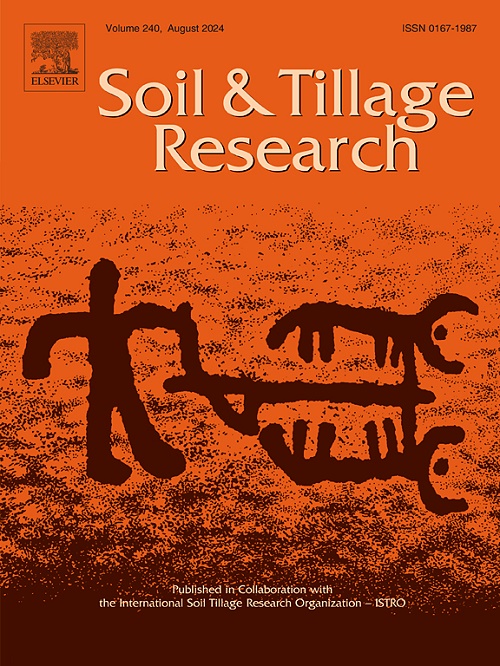洱海流域农田土壤有机碳储量估算:时空光谱信息的贡献
IF 6.1
1区 农林科学
Q1 SOIL SCIENCE
引用次数: 0
摘要
传统的土壤有机碳(SOC)预测方法应用于地形复杂、地块破碎、种植结构多样的高原湖盆地存在较大的不确定性。在本研究中,我们试图克服传统方法在生态脆弱和农业重要的高原湖盆中预测有机碳含量的局限性。本研究结合多源遥感数据和土壤成土模型,将分散的土壤数据、空间特征和时空变化有效地整合到7类成土因子中。结合卷积神经网络、长短期记忆网络和注意机制(CNN-LSTM_A),提取土壤形成因子的时间-空间-光谱(TSS)特征,计算输入变量的权重,从而提高土壤有机碳含量的预测精度和可解释性。最后,基于两期表层土壤(0 ~ 20 cm)实测数据,构建了高原湖盆区农田有机碳储量年际变化的精确估算框架。结果表明,CNN-LSTM_A在预测精度和时间可转移性方面均优于6种比较模型:RMSEmean和MAEmean分别降低了1.6796-1.9558 g kg−1和0.7835-1.2400 g kg−1,R2mean、RPIQmean和CCCmean分别提高了0.0970-0.1273、0.3863-0.5778和0.0773-0.1100。此外,作物长期生长信息间接反映了有机碳积累过程,有助于提高预测精度。2007-2016年,洱海流域农田有机碳含量的空间异质性受植被和地形共同驱动,植被对土壤有机碳含量的影响较大。洱海西侧和北侧有机碳含量较高,表现出一定的时间动态特征。在此期间,农田有机碳含量总体呈增加趋势,显著增加集中在盆地北部。但由于耕地面积的减少,土壤有机碳总储量呈下降趋势(4.366 Tg C和4.136 Tg C)。具体而言,土地利用变化间接损失了0.475 Tg C,而未改变农田面积由于土壤有机碳含量的增加而直接贡献了0.245 Tg C。该研究不仅为洱海流域生态管理和农业可持续发展提供了重要的数据支持,也为其他生态脆弱地区的生态保护和更广泛的碳循环研究提供了科学依据。本文章由计算机程序翻译,如有差异,请以英文原文为准。
Estimating cropland soil organic carbon stock in Erhai Lake basin: Contribution of temporal-spatial-spectral information
Traditional soil organic carbon (SOC) prediction methods exhibit significant uncertainty when applied to croplands in plateau lake basins, which are characterized by complex terrain, fragmented plots, and diverse cropping structures. In this study, we endeavored to overcome the limitations of traditional methods in predicting SOC content in the ecologically fragile and agriculturally vital plateau lake basins. This study effectively integrates dispersed soil data, spatial features, and temporal-spatial variations into seven categories of soil-forming factors by combining multi-source remote sensing data and a soil-pedogenic model. Furthermore, to extract the temporal-spatial-spectral (TSS) features of soil-forming factors and calculate the weights of input variables by integrating the convolutional neural networks, long short-term memory networks, and attention mechanism (CNN-LSTM_A), thereby enhancing the predictive accuracy and interpretability of SOC content. Finally, based on two periods of measured topsoil (0–20 cm) sample data, we constructed a precise estimation framework for interannual variations in cropland SOC stocks in the plateau lake basin. The results showed that CNN-LSTM_A outperformed six comparison models in both prediction accuracy and temporal transferability: reducing the RMSEmean and MAEmean by 1.6796–1.9558 g kg−1 and 0.7835–1.2400 g kg−1, increasing the R2mean, RPIQmean, and CCCmean by 0.0970–0.1273, 0.3863–0.5778, and 0.0773–0.1100, respectively. Additionally, the results confirmed that long-term crop growth information indirectly reflects the SOC accumulation process, contributing to improved prediction accuracy. From 2007–2016, the spatial heterogeneity of cropland SOC content in the Erhai Lake basin was jointly driven by vegetation and topography, with vegetation being the more influential factor. Higher SOC content was observed in regions on the western and northern sides of Erhai Lake, exhibiting certain temporal dynamics. During this period, cropland SOC content exhibited an overall increasing trend, with significant increases concentrated in the northern basin. However, due to a reduction in cropland area, total SOC stocks showed a decreasing trend (4.366 Tg C and 4.136 Tg C). Specifically, 0.475 Tg C was indirectly lost due to land use changes, while areas of unchanged cropland directly contributed a gain of 0.245 Tg C due to increasing SOC content. This research not only provides critical data support for ecological management and sustainable agricultural development in the Erhai Lake basin but also offers scientific backing for ecological protection and broader-scale carbon cycling studies in other ecologically fragile areas.
求助全文
通过发布文献求助,成功后即可免费获取论文全文。
去求助
来源期刊

Soil & Tillage Research
农林科学-土壤科学
CiteScore
13.00
自引率
6.20%
发文量
266
审稿时长
5 months
期刊介绍:
Soil & Tillage Research examines the physical, chemical and biological changes in the soil caused by tillage and field traffic. Manuscripts will be considered on aspects of soil science, physics, technology, mechanization and applied engineering for a sustainable balance among productivity, environmental quality and profitability. The following are examples of suitable topics within the scope of the journal of Soil and Tillage Research:
The agricultural and biosystems engineering associated with tillage (including no-tillage, reduced-tillage and direct drilling), irrigation and drainage, crops and crop rotations, fertilization, rehabilitation of mine spoils and processes used to modify soils. Soil change effects on establishment and yield of crops, growth of plants and roots, structure and erosion of soil, cycling of carbon and nutrients, greenhouse gas emissions, leaching, runoff and other processes that affect environmental quality. Characterization or modeling of tillage and field traffic responses, soil, climate, or topographic effects, soil deformation processes, tillage tools, traction devices, energy requirements, economics, surface and subsurface water quality effects, tillage effects on weed, pest and disease control, and their interactions.
 求助内容:
求助内容: 应助结果提醒方式:
应助结果提醒方式:


